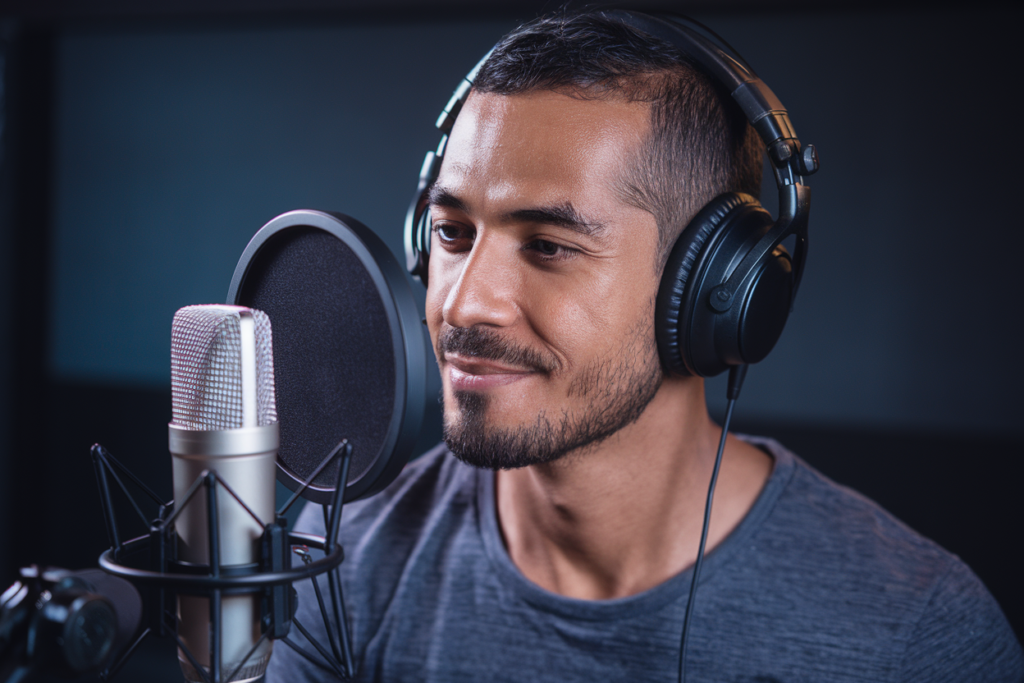Key Takeaways
- Understanding Lip-Syncing: Effective lip-syncing goes beyond matching words; it requires a seamless connection between visuals and audio to enhance emotional depth.
- Importance of Synchronization: Proper lip-syncing is essential for bringing characters to life, maintaining audience immersion, and respecting cultural nuances in Arabic expression.
- Challenges in Lip-Syncing: Timing issues, regional dialects, and maintaining authenticity can complicate the lip-syncing process for voice artists.
- Key Techniques: Pre-production planning, clear recording practices, vocal warm-ups, and attention to energy levels are crucial for successful lip-syncing in Arabic voiceovers.
- Recommended Tools: Utilize software like Adobe Audition and Final Cut Pro that offer multitrack editing capabilities and real-time monitoring for precise synchronization.
- Cultural Considerations and Timing: Understanding regional dialects and adjusting pacing during recordings are vital best practices that contribute to the authenticity and effectiveness of Arabic voiceovers.
Ever wondered how to make your Arabic voiceovers truly pop? Lip-syncing effectively isn’t just about matching words; it’s about capturing the essence of emotion and culture. With the right techniques, you can elevate your projects and ensure they resonate with your audience.
Whether you’re a seasoned pro or just starting out, mastering the art of lip-syncing Arabic voiceovers can be a game changer. It enhances storytelling and creates an immersive experience that keeps viewers engaged. Ready to dive in? Let’s explore some proven strategies that will help you sync those voices flawlessly while preserving authenticity and impact.
Understanding Lip-Syncing
Lip-syncing in voiceovers goes beyond mere word alignment; it’s about creating a seamless connection between the visuals and audio. This synchronization enhances emotional depth, making your project resonate with viewers more effectively.
Importance of Lip-Syncing in Voiceovers
Lip-syncing plays a crucial role in the effectiveness of your voiceover. When done right, it brings characters to life, allowing audiences to feel the story’s emotions. Proper synchronization ensures that mouth movements match spoken words, which maintains audience immersion and credibility. Effective lip-syncing also respects cultural nuances inherent in Arabic language expression, enhancing relatability for viewers.
Challenges Faced in Lip-Syncing
Achieving flawless lip-syncing poses several challenges for voice artists. One common issue is timing; often, dialogue needs to fit specific visual cues without losing meaning or emotion. Additionally, accents and regional dialects can complicate this process since phonetic variations might not align perfectly with visual expressions. Adapting performance style while staying true to the original content also requires skillful navigation from voice talents—this balance is essential for authentic storytelling.
By understanding these elements of lip-syncing, you can better appreciate its significance and complexity in producing engaging Arabic voiceovers that capture both nuance and authenticity.
Techniques for Effective Lip-Syncing
Effective lip-syncing in Arabic voiceovers involves a few key techniques that ensure your performance resonates with the audience. Mastering these methods enhances both the authenticity and emotional impact of your work.
Pre-Production Planning
Planning plays a crucial role in successful lip-syncing. Start by thoroughly reviewing the script to understand character emotions and pacing. Identify specific moments where emotion peaks or shifts, as these cues guide your delivery. Create a storyboard if possible, mapping out scenes to visualize timing and mouth movements. This foresight helps you align your voice with visuals seamlessly. Consider regional dialects and accents; they add depth and authenticity, making it essential to adapt accordingly based on the target audience.
Recording Techniques
When recording, focus on capturing clear audio while maintaining proper alignment with video content. Use high-quality microphones to enhance sound fidelity, ensuring every nuance of your voice comes through distinctly. Maintain consistent energy levels throughout; fluctuations can disrupt synchronization even if words match up perfectly. Adjust your speaking rate as needed—slowing down or speeding up can help you fit dialogue naturally into scenes without compromising clarity or emotional delivery.
Employ vocal warm-ups before recording sessions; they prepare your voice for optimal performance and improve articulation. Experiment with distance from the microphone during takes, as varying proximity affects tonal quality and volume—finding that sweet spot is vital for effective communication.
These techniques not only refine your skill set but also elevate the overall quality of Arabic voiceovers you produce, creating engaging experiences that resonate deeply with viewers.
Tools and Software for Lip-Syncing
Effective lip-syncing requires the right tools to help you align voiceovers with visual elements seamlessly. Various software options can enhance your workflow and ensure accurate synchronization, making your voice acting stand out.
Recommended Software for Voice Actors
- Adobe Audition
Adobe Audition offers robust audio editing features ideal for voice actors looking to refine their recordings. Its multitrack capabilities allow you to manage multiple audio layers easily, ensuring that your lip-syncing aligns flawlessly.
- Final Cut Pro
Final Cut Pro is excellent for video editing but also provides powerful audio handling tools. You can adjust timing directly within the timeline, which simplifies the process of aligning dialogue with character movements.
- Camtasia
Camtasia combines screen recording with video editing functionalities, making it user-friendly for beginners and experienced voice artists alike. Its simple interface allows you to synchronize voiceovers with visuals without a steep learning curve.
- Reaper
Reaper is a cost-effective digital audio workstation that supports various plugins and effects tailored for voiceover work. Its flexible routing options facilitate precise adjustments in timing and pitch during recording sessions.
- iZotope RX
iZotope RX specializes in audio repair but also includes features beneficial for voice actors, like noise reduction and spectral editing tools that enhance clarity in your recordings.
Features to Look for in Lip-Syncing Tools
When selecting tools for lip-syncing, keep an eye out for these essential features:
- Multitrack Editing: Ensure the software allows simultaneous management of multiple tracks so you can layer sound effectively.
- Real-Time Monitoring: Choose software that provides real-time playback feedback as this helps catch any discrepancies between speech and movement.
- Waveform Visualization: Opt for programs that display waveforms clearly; this feature aids in identifying peaks corresponding to spoken words.
- Audio Effects: Look for built-in effects such as equalization or compression; they improve overall sound quality while maintaining clarity during synchronization.
- User-Friendly Interface: Select intuitive interfaces; ease of navigation reduces stress when working under tight deadlines or complex projects.
Using the right tools not only enhances your productivity but also elevates your performance as a voice artist by ensuring accuracy in every project you tackle.
Best Practices for Lip-Syncing Arabic Voiceovers
Lip-syncing effectively in Arabic voiceovers involves understanding cultural nuances and mastering timing. You can elevate your voiceover projects by applying these best practices.
Cultural Considerations
Cultural context plays a significant role in lip-syncing. Arabic dialects vary widely across regions, each carrying unique expressions and tones. When selecting a voice artist, consider their familiarity with the specific dialect relevant to your project. For instance, a voice actor from Egypt may capture emotions differently than one from Lebanon or Morocco.
Understanding cultural references is also crucial. Certain phrases or gestures might resonate more with audiences familiar with local customs. This awareness helps create authentic character portrayals that connect deeply with viewers, ensuring your story feels genuine and relatable.
Timing and Pacing
Timing directly impacts the believability of your Arabic voiceover. Aligning speech rhythms with mouth movements creates realism that captivates audiences. Start by closely analyzing the original video footage; note how characters express themselves through pauses and emphatic moments.
Adjust pacing during recording sessions to avoid rushed deliveries. A well-timed pause can enhance emotional impact, while too fast of a delivery risks losing clarity and connection with listeners. As you practice lip-syncing, experiment with varying speeds to find what resonates most naturally within the scene’s context.
Incorporating these best practices not only refines your skills as a voice talent but also enriches the overall quality of Arabic voiceovers you produce, leading to engaging experiences for viewers.
Conclusion
Mastering the art of lip-syncing Arabic voiceovers is crucial for creating compelling and authentic narratives. By focusing on emotional expression and cultural nuances, you can significantly enhance your storytelling abilities. Using the right tools and techniques will not only streamline your workflow but also ensure that your performances resonate with audiences.
Incorporating regional dialects and understanding timing are essential steps toward achieving realistic synchronization. As you refine these skills, you’ll find that your voiceovers become more engaging, drawing viewers into the world you’ve created. Embrace the challenges that come with this craft, and remember that each project is an opportunity to grow as a voice artist.
Frequently Asked Questions
What is the importance of lip-syncing in Arabic voiceovers?
Lip-syncing is crucial in Arabic voiceovers as it ensures that mouth movements align with spoken words. This alignment enhances storytelling and helps convey emotions and cultural nuances, creating a more engaging experience for viewers. Effective lip-syncing brings characters to life and maintains audience immersion.
What challenges do voice artists face with lip-syncing?
Voice artists encounter challenges such as timing discrepancies, varying accents, and regional dialects that complicate synchronization. These factors can make it difficult to match speech accurately with mouth movements while preserving authenticity within the narrative context.
What techniques can improve lip-syncing performance?
Improving lip-syncing performance involves thorough script review to understand character emotions, creating storyboards for visual timing, and adapting to specific dialects. Additionally, vocal warm-ups, consistent energy levels during recording, and experimenting with microphone distance are recommended strategies.
Which software tools are best for lip-syncing Arabic voiceovers?
Recommended software for effective lip-syncing includes Adobe Audition for audio editing, Final Cut Pro for video handling, Camtasia for screen recording/editing, Reaper as an affordable DAW option, and iZotope RX for audio clarity enhancement. These tools streamline workflow and ensure accurate synchronization.
How do cultural nuances affect Arabic voiceover performances?
Cultural nuances play a significant role in Arabic voiceover performances by influencing dialect selection and character portrayal. Understanding these elements enhances audience connection through relevant cultural references and ensures authentic representation of characters within their specific contexts.
What are some best practices for achieving effective lip-syncing?
Best practices include selecting a familiar voice artist for the specific dialect, analyzing original footage to align speech rhythms with mouth movements, adjusting pacing during recordings to avoid rushed deliveries, and experimenting with speeds to find natural fits within scenes.







